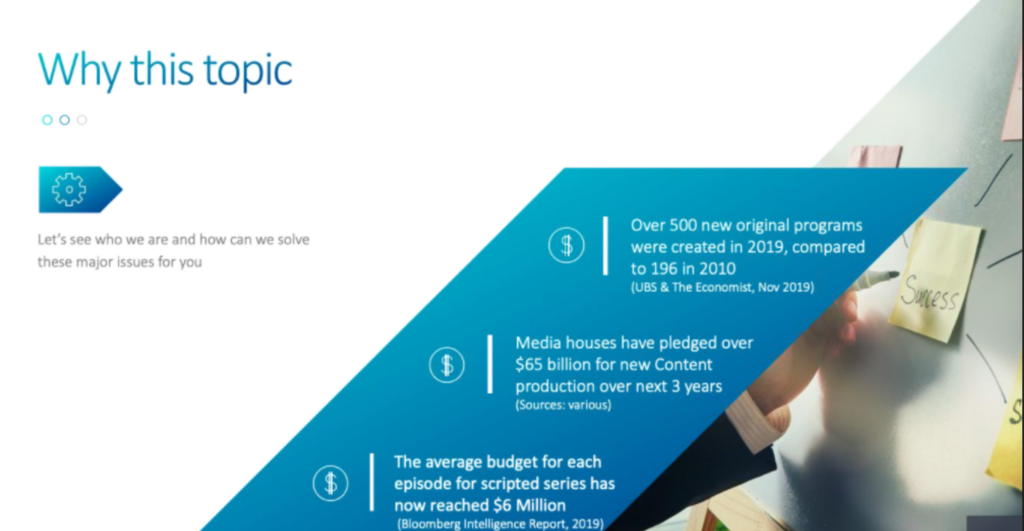HITS

Invenio Exec Touts Solutions for M&E Companies to Overcome Key Production Challenges
Story Highlights
Media and entertainment companies are scrambling to overcome the onslaught of simultaneous productions and increased costs that have come along with the explosion of new content due to over-the-top (OTT) streaming platforms, according to Kedar Patwardhan, SVP and BU leader-Media, Entertainment & Finance at Invenio Business Solutions.
“In the industry, we all know, especially in the last four or five years, we have seen a big, big increase in the number of online platforms — and that has changed a few things dramatically when it comes to the production side of the business,” he pointed out June 23, during the webinar “How to Increase Spend Control and Reduce Inefficiency in Your Production Process.”
As an example, in 2019, more than 500 new original programs were created, up from just 196 in 2010, he said, citing UBS and The Economist data from November.
Although there are some new players, that number has grown so high largely because “the same production houses are creating a lot more content now,” he said. While a production house might have been handling three simultaneous productions on average a few years ago, it is now handling 7-8 at the same time, which creates significant challenges for them, he noted. “And we are just about getting started,” he added.
Media houses, meanwhile, have pledged over $65 billion for new content production over the next three years, he said, adding that, by some estimates, it will be more than $100 billion.
The average budget for each episode of a scripted TV series has also reached a whopping $6 million, he noted, citing a Bloomberg Intelligence Report from 2019.
The increased cost, combined with the increased number of productions, has created a major challenge that the industry has not faced before, he told viewers.
 Seventy-two percent of all movies made in the past 15 years cost more than their planned budget, he also pointed out, citing a Variety report from late 2018.
Seventy-two percent of all movies made in the past 15 years cost more than their planned budget, he also pointed out, citing a Variety report from late 2018.
Meanwhile, today, there are, on average, four siloed systems in use for production budgeting, he said, citing Gartner data from 2019.
Companies have been facing issues that include a “mismatch of data” for a while and the problems remain large, without a “smooth and nice solution,” he said.
Below-the-line production costs and “even many of the above-the line costs tend to spiral out of control before the media house even knows it or the production manager knows it,” he also said.
The OTT platforms, meanwhile, are “looking at two ways to turn profits and, by various estimates, most of the OTT platforms talk about [it taking] three to five years time to turn profitable from their launch,” with a target to reach a few million subscribers, he said.
The first way to increase profits is to increase their subscriber base, “which is what everyone is doing right now — trying to go nationwide and then go to international subscribers” to generate more revenue on content, he noted. They then try to “lock in” the customers and increase their lifetime value, then convert them to be loyal subscribers and hopefully be able to charge them more for subscriptions, he said.
 The second way for them to increase profits is to manages costs better, he noted, pointing to optimizing production costs as “one of the largest cost components,” followed by marketing, distribution, technology and other costs, he said.
The second way for them to increase profits is to manages costs better, he noted, pointing to optimizing production costs as “one of the largest cost components,” followed by marketing, distribution, technology and other costs, he said.
The centerpiece of the discussion was about the Invenio Content Financials solution that he noted was developed for media organizations on SAP technology for easy implementation. The offering provides tighter controls and financial transparency throughout the creation and acquisition of content, enabling media companies to rein in spending and manage the entire lifecycle of content, according to Invenio. It’s also agile and integrates with other departments (like rights management) to form one automated system that gives companies clear reports on real-time spend, with an efficient workflow and approval system for effective end-to-end financial control.
Among Patwardhan’s many points during the detailed discussion was that amortization “has become a bigger problem than it ever was before.”
He turned to the case study of a specific customer that has used his company’s solution: The Star Group (creators of Hotstar and now part of Disney Group), which he said was able to increase its overall and finance operational efficiency. It now has 300 million active users and a content library of $8 billion and growing, he said, noting it produces 30,000 hours of content each year.
Asked during the Q&A if Invenio had plans to add artificial intelligence (AI) and machine learning (ML), he said: “Absolutely, yes it is” on the roadmap. “There are two ways we are looking to add it: In the budgeting part of it itself… depending on the type of content… and the historical data…. Also during the exhibition part” for invoice processing as an example, he said, noting the technology will “make it more efficient [and] also help in financial amortization, which is getting more complex.”
He also pointed out during the Q&A: “There are obstacles that we face, but we are quite encouraged by the response that we [are getting] from the industry, where there’s a lot more openness – a lot more willingness to change and adapt new processes, stay competitive… and also create breakthrough innovations, which will define the industry for the future.”
Also during the Q&A, Richard Whittington, SVP-M&E, Industries & Customer Advisory at SAP, pointed out how important it is for M&E companies to have a “better sense on cash flow.” He added: “I know everybody’s got COVID or Zoom fatigue, but you cannot escape the impact of what we’re going through, and so cash flow in any company — in any industry — is top of mind and paramount. So what we’re trying to do, I think, by bringing efficiencies is free up some cash.”









